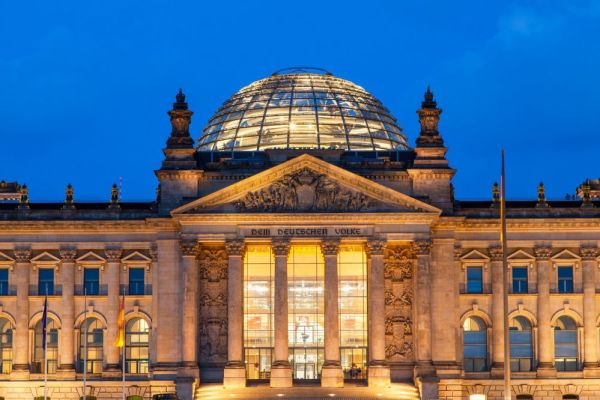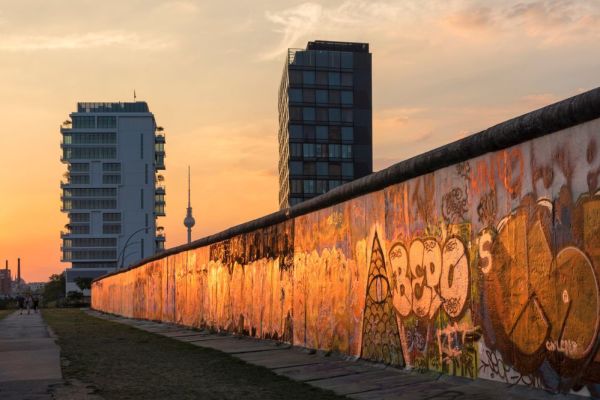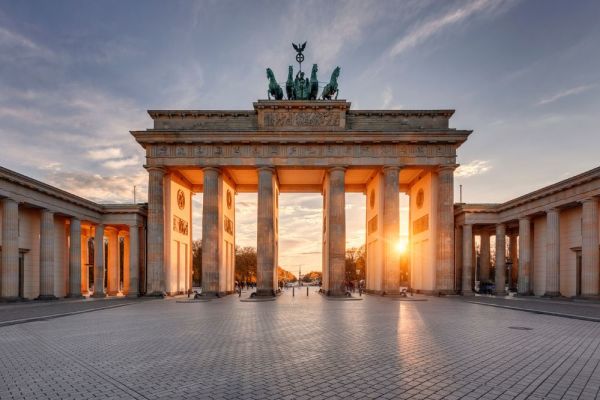BerlinTravel Guide
Berlin will take you on an emotional journey just as much as present you with a fascinating roadmap of things to do. This city has played a major role in the history of the world as we know it, with the Brandenburg Gate, the Berlin Wall, Checkpoint Charlie and many other landmarks on the must-see list. Then there’s the Berlin of today: an inspiring, fun-loving creative hub that encourages big ideas and keenly supports the entrepreneur in everything from cuisine to couture. Ooh and don’t forget the parks. And that coffee...If you’re planning a visit, explore our Berlin travel guide and find out how to make the most of your time in Germany’s fascinating capital. We’ve collected the best tips from our travel experts, and have all sorts of suggestions for things to do, the best time to travel, where to stay in Berlin, getting around and more.
Berlin quick facts
Language
National language
German
Beverages
Bottle of Coke/Pepsi (330ml)
CAD $4.43
Local time
Saturday
6:21pm
Currency
Euro
CAD $1.00 = EUR €0.63
Eating out
Restaurant meal (casual dining)
CAD $23.74
Electricity
Plug type: C
2 pins • 230V
Explore Berlin
Where to stay in Berlin?
The number one question asked by visitors is ‘where to stay in Berlin?’ The city is quite spread out, which means a little planning is needed to determine the best places to stay in Berlin that give you easy access to the sites you wish to see. Thankfully, transport in Berlin is quite cheap, so you can choose to stay somewhere close to shopping districts and still enjoy all the culture that the city has to offer. Many of the best places to stay in Berlin are close to public transport, including Mitte, Kreuzberg, and Charlottenburg.
The neighbourhood of Kreuzberg is home to artists and students, offering an ever-evolving vibe. Diverse in culture, Kreuzberg has always been considered trendy and this extends to the accommodation. Some of the best hostels are found here, as well as some beautiful four-star hotels. The food scene is another great reason to stay here, with street food and bars close by.
Close to the East Side Gallery and many other East Berlin attractions, Friedrichshain has some of the best budget-style hotels. Here you'll find modern and trendy options, which give you comfort and convenience. Staying in Friedrichshain means you are within walking distance of many historical attractions, including Checkpoint Charlie, as well as being close to the U-Bahn for day trips.
If you want to enjoy some of the best shopping in Berlin, Charlottenburg is a great location to stay. An upscale area, the historic Hotel am Steinplatz and Waldorf Astoria hotels are both located here. Previously the centre of West Berlin, Charlottenburg has a great residential vibe, while also providing easy access to restaurants, bars and shops.
When museums and cultural events are your priority, accommodation in Mitte puts everything on your doorstep. Translated to English, Mitte means ‘middle', which gives you an indication of its proximity to everything. Enjoy some of the best shopping in the city, spectacular dining, and great bars. Mitte accommodation tends to be more upmarket, so be sure to factor that into your budget.
If the beauty of Berlin's buildings and architecture captures your eye, Prenzlauer Berg is a great spot for accommodation. Blending modern hotels with bohemian bars, there's something here to suit every accommodation budget. Close to Mauerpark, Prenzlauer Berg provides easy access to a number of stunning attractions within the area.
For Berlin accommodation off the tourist track, Neukolln is a perfect spot. Considered a neighbourhood ready to emerge as the next big thing in Berlin, the vibrant atmosphere makes this a beautiful spot to stay. There are many comfortable and affordable hotels located close to some of Berlin's best sights.
Believe us when we say, this is just the start. Book your Berlin accommodation today!
Things to do in Berlin
There are numerous things to do in Berlin for all types of travellers, from history buffs to foodies. Enjoy some of the best shopping in Berlin with a visit to Kurfurstendamm or the multi-level mall KaDeWe. With an amazing cafe culture, street food, parks, and plenty of museums and galleries, Berlin has plenty to fill your itinerary.
Perhaps the most recognisable landmark of Berlin, the Brandenburg Gate is one of the first sites any visitor wants to see. A symbol of the division between East and West Berlin, the Brandenburg Gate is a surviving historical city gate. The neo-classical style, inspired by the Acropolis in Athens, has to be seen in person to be appreciated.
Dividing the city for almost 30 years, sections of the Berlin Wall are still in place, providing some insight into its history. The East Side Gallery, found on the banks of the Spree, was established after the fall of the Berlin Wall. An open-air gallery, sections of the wall have been painted by 118 artists from 21 countries.
The opulent stylings of Berlin's largest palace, Charlottenburg Palace, make this a stop well worth exploring with a day pass. From the gilded gallery to the festival halls, Charlottenburg Palace is a popular Berlin landmark you'll definitely want to see. If you happen to visit in December, you can even take in the Christmas markets, where you can purchase arts, crafts, and traditional German festive treats.
A visit to Pergamon Museum in Berlin is a must if art of the Ancient East intrigues you. Filled with artefacts that were gathered from Iran, Egypt, the Caucasus and Asia, the museum is beautifully styled to allow for up-close viewing. Be sure to see the Ishtar Gate of Babylon, as well as the Roman Market Gate of Miletus, which date back to the 2nd century.
Mauermuseum, Haus am Checkpoint Charlie (Checkpoint Charlie Museum) takes its name from the crossing point on the Berlin Wall. Showing escape plans from East Germany, as well as original pieces of the Berlin Wall, the museum is a fascinating look at the role the wall played in the city's history. You'll soon see why this is one of the most visited museums in Berlin.
A converted bunker, Sammlung Boros is an unlikely home to some of the most contemporary art in Berlin. Filled with a range of mediums, including sculptures, spatial installations and performance-based works, Sammlung Boros is also home to the private Boros Collection. The museum hosts work from artists Wolfgang Tillmans, Tobias Rehberger and Damian Hirst, with almost 500 pieces on display.
Home of the German parliament, the Reichstag is an amazing piece of architectural work and a historical landmark. With some sections still bearing bullets and graffiti left by Soviet soldiers, the Reichstag is a blend of old and new Germany. In addition, the Reichstag has both permanent art collections and changing exhibitions for viewing. There's an onsite restaurant if you fancy something to eat after exploring the grounds.
Officially opened in 2005, the Holocaust Memorial can be found in the middle of the city. Stretching more than 19,000m2, the memorial is a place of contemplation in an unconventional design. Along with the memorial is the information centre, where you can find photographs, personal letters and diary entries from those who spent time here.
For 360° views of Berlin, Fernsehturm (or the ‘TV Tower'), is the place to visit. The tallest structure in Germany, stretching 368m tall, the TV Tower's viewing platform is not to be missed. Like many Berlin landmarks, the tower is steeped in history but also acts as a symbol of modern Germany. You'll find a bar and restaurant here, so you can enjoy a cocktail while taking in the views.
Detailing the history of Jewish culture in Germany, the Jewish Museum Berlin is a sight to behold. The architecture is a mixture of angles and zigzags, placing visitors within a piece of artwork. From the entrance, you may choose three different paths, from the Garden of Exile to the Holocaust Axis and the Axis of Continuity.
Established in 1990, the East Side Gallery is a fabulous place to understand some of Berlin's history. Once a section of the wall that divided Berlin, the East Side Gallery is the longest open-air gallery in the world. Painted with iconic imagery, including the well-known ‘Fraternal Kiss', you will want to bring your camera as you wander this section.
Looking for an immersive experience? Then a Berlin tour is the way to go.
Berlin travel tips
When you’re planning a holiday, it’s good to be up to date on the latest Berlin travel tips. Knowing which essential visa information you require, as well as which Berlin airport you will be flying into, gives you the basics to plan for the trip of a lifetime. Be prepared to enjoy everything this amazing city has to offer, from dining to shopping and history galore. While German is the main language spoken, you’ll be happy to know many locals speak English as well. For more essential Berlin travel advice, be sure to read the details below.
If you're visiting Berlin as a tourist and staying less than 90 days, you won't need to apply for a German visa. However, as is the case with many international destinations, you'll need to ensure your Australian passport has a minimum of six months' validity from your planned return date. Should you plan to cross the border during your visit, be sure to carry your passport.
There's an endless array of Berlin food experiences to enjoy. The city has so many options to suit each type of budget, ensuring you can grab a quick snack or enjoy a long dinner paired with tasty German wines. In addition to an amazing restaurant scene, there's plenty of street food to be enjoyed here too, including the traditional currywurst.
German plugs and voltage are different from Australia, so a universal adapter can make your stay a little easier. The electrical current is 220V, alternating current, with the wall plug shaped with two round plugs. Before using any appliances, it's best to double check them for compatibility with German electrical plugs.
Currently, there are two international airports in Berlin: Tegel and Schonefeld. The new Berlin Brandenburg International Airport (BER) is in construction in Schonefeld and will take over as the only airport once finished. Flights to Berlin are available from most Australian and European cities, and transport both to and from the airport is plentiful.
As of 2002, the currency in Germany is the euro, which is the official currency of the European Union. The euro's denominations are similar to the breakdown of the Australian dollar, with banknotes starting at €5. When converted to the Australian dollar, the Euro has remained quite strong, so keep that in mind when exchanging money for local cash.
Most restaurants and hotels factor service charges into your bill, so tipping in Berlin is generally not required. While it's certainly acceptable to tip if you wish, it isn't expected for many places. You can also check the menu of a cafe or restaurant to see if the cost of service is advised.
The main language in Berlin is German, and it's always good manners to learn a few local phrases if you're planning a visit. English is spoken in many official sites, and many locals will also understand some English phrases. Words like hotel, taxi and restaurant are also easily recognisable, even when written in German.
Flights to Berlin
Berlin food and drink
As a multicultural city, Berlin’s food and drink is hugely varied. Enjoy dinner in a Michelin-starred restaurant one night, then sample fast and fresh produce in one of the many eateries at KaDeWe the next. Traditional German cuisine is available in almost every avenue, from pork knuckle to schnitzel. If you’re hungry, the sheer number of Berlin restaurant precincts ensure your tummy will always be satisfied. The market halls are a great way to try street food, while international cuisine is sprinkled throughout the city. Once you’ve eaten, a drink in one of the inner city’s bars is a great way to finish your night.
Trying out Berlin's restaurant precincts is a great way to experience some of the delights of the city. Whether you're searching for a quick and cheap burger or you want to savour a fine-dining experience, Berlin has everything on offer. Head to Kreuzberg's food stalls for a quick lunch or Mitte to enjoy a romantic dinner.
Off the tourist track, neighbourhoods like Neukolln are home to some of the best Berlin cafes and coffee spots. Whether you like to start your day with a hot latte or you want to grab a snack during the day, finding the best coffee in Berlin is a fun task to undertake.
You'll be spoiled for choice by Berlin's food markets, both outdoor and indoor. Here you'll find an abundance of snack foods and gourmet options, including delicious local cheeses and German wines. Try Kollwitzplatz's ‘ecomarket' in Prenzlauer Berg for some produce fresh from the farm, or head to Markthalle Neun for some spectacular street food.
Germany will always be known for its beer, and the amazing Berlin bars and nightlife provide a great way to taste a few! During the summer, you can enjoy a nice cold beverage in one of the many beer gardens or in a rooftop bar. Try Friedrichstrabe if you want to throw yourself into the Berlin bar scene.
Get a real taste for the local cuisine by booking a Berlin tour.
Berlin through your eyes
Where to shop in Berlin?
There are endless options when it comes to Berlin shopping. From large department stores and boutiques offering the best in Berlin fashion, to outlets, small shops and craft markets, you’ll be spoiled for choice. Wander Kurfurstendamm for gorgeous Berlin fashion, or head to KaDeWe to find an almost overwhelming range of stores, cafes and restaurants. Bikini Berlin and the shopping districts of Mitte are also well deserving of some browsing time – you’ll have no trouble finding something to buy in Berlin! Just like the rest of the city, the shopping here is a beautiful fusion of old and new.
One of the most popular shopping districts in Berlin, Kurfurstendamm is the place to visit for bargains and the latest fashion. Stretching 3.5km along the western city centre, Kurfurstendamm is home to famous international labels, as well as boutique stores. The side streets are also well worth exploring for cafes and bookshops.
The Mitte shopping district is worthwhile seeking out, particularly for designer wares. Here you'll find gorgeous small boutiques and independent labels, as well as numerous cafes when you need to refuel. Located in East Berlin, Mitte (‘the middle') is also home to galleries and beautiful concept stores, so you're sure to find something unique.
The first concept mall in Germany, Bikini Berlin is home to modern designs in both fashion and architecture. Overlooking the city and the zoo, you can dine in one of the many restaurants, browse the boutiques for beautiful fashion, and purchase something from emerging designers. Housing permanent and pop-up shops, there's always something new to see at Bikini Berlin.
Known as Kaufhaus des Westens, or the ‘Department Store of the West', KaDeWe is the largest department store in Europe. Across six storeys, you'll find luxury brands such as Prada, Rolex and Cartier, fashion, beauty, homewares, and two entire floors dedicated to food and drink. KaDeWe is spread over 60,000m2, so put on some comfortable walking shoes before you begin shopping!
If you're keen to check out Berlin markets, try Nowkoelln Flowmarkt for upcoming fashion and accessory trends. Grab a coffee and wander the many stalls here to find great gifts or fashion items. Vintage markets, such as Arkonaplatz, are perfect to browse for clothing, hats and accessories. You'll also find beautiful (and affordable) Scandinavian furniture and homewares.
When is the best time to travel to Berlin?
The weather in Berlin can have some bearing on your holiday plans, so knowing what you want to do will dictate the best time to travel to Berlin. Seasons are fairly true to type, with winters being quite cold and summer warm. Rainfall in Berlin remains stable throughout much of the year, even during the warm weather of July and August. Whatever the season, Berlin is an amazing city that takes advantage of seasonal conditions with open-air festivals or even schneeballschlacht (snowball fights in the middle of Tiergarten Park).
Summer in Berlin can be hot, with the temperature sometimes reaching 30°C. While the days tend to be quite warm, the weather can change quickly, so a rain jacket is always useful. Some of the city's best attractions and events take place in summer, so this is a great time to visit. Appropriate clothing: Shorts and a t-shirt Don't forget: A hat and sunscreen.
During winter in Berlin, it's not uncommon for temperatures to drop to -10°, or possibly even lower. The average temperature during winter tends to be around 0°C. Frost and snow occur regularly in January and February, with the Spree River sometimes freezing over. Appropriate clothing: Thick winter jackets, beanie and scarf Don't forget: A pair of gloves!
The beautiful colouring of Berlin in autumn makes it a great time to visit. Temperatures are quite similar to spring, with an average between 12 and 20°C during the day. When you're planning on sightseeing, take a rain jacket or a jumper to keep you warm. Appropriate clothing: Long pants and a t-shirt or shorts and a jumper Don't forget: A rain jacket in case of showers.
The mild weather of spring in Berlin makes this a wonderful time to experience all the city has to offer. With the average temperature ranging between 12 and 20°C, spring weather may occasionally be accompanied by a shower of rain, so a waterproof jacket or umbrella should be carried in your day bag. Appropriate clothing: Long pants and a t-shirt or shorts and a jumper Don't forget: Good walking shoes.
Don't miss out. Book your Berlin flight today!
How to get around Berlin
Transport in Berlin is not only easy to navigate but also cheap to use. There are more than 20 different train lines between the overground (S-Bahn) and underground (U-Bahn) systems, as well as bus, tram and even ferry lines. Of course, there’s also the option of hailing one of the Berlin taxis for a convenient transport option as well. If you like to get a little more active during your visit, walking in Berlin is also a good idea, with a number of attractions in close proximity. Otherwise, take advantage of the many pathways with Berlin bike hire, and see the city from the seat of a bicycle.
Sometimes you just want to take the most convenient transport option available, which is when Berlin taxis come in handy. Many of the main streets and landmarks have nearby taxi ranks, as well as most hotels. Similar to Australia, taxis are metered, so you can see the final cost as you arrive at your destination.
Berlin bike hire is simple, with rental stations located throughout the city. Bike lanes can be found almost everywhere in Berlin, allowing for easy sightseeing. As with any time you're cycling, be mindful of other road traffic and obey the road rules. Once you set off, either follow the pathways to see where they take you, or plan your route to get to the places you wish to visit.
When it comes to Berlin public transport, the U-Bahn and S-Bahn are hard to beat. The U-Bahn operates all night on Fridays and Saturdays, with regular services available between 4am through to 12:30am. While the S-Bahn (aboveground) system is less frequent, it's useful for travelling longer distances. For sightseeing, the tram and bus system is simple and cost-effective.
If you plan on walking in Berlin, keep in mind that the city is quite spread out. You might be able to cover some of the main tourist destinations, such as the Brandenburg Gate and the Memorial to the Murdered Jews of Europe, are within walking distance of each other, but some will require bike hire or public transport to reach. There are also guided walking tours which take in a lot of the city's sights within three or four hours, providing a good starting point for exploring Berlin.
Let us help you organise your own wheels for exploring. Hire a car in Berlin today!
What are the best parks in Berlin?
While the architecture of the city is renowned, Berlin parks and squares are not to be underestimated. As expected, you’ll find touches of old and new Berlin, from the leftover reminders of the wall in Mauerpark to the views across to Brandenburg Gate that can be enjoyed from Tiergarten. Any visit to Berlin should include a walk through Tiergarten, the city’s answer to New York City’s Central Park. Relax on the grass in the sunshine, have a picnic, or enjoy some of the free events hosted in one of Berlin’s parks and piazzas.
Part of the border strip of the Berlin Wall until 1989, Mauerpark officially became a public park in 1994. Take a walk along the route where the wall used to be, relax on the grass and soak up the atmosphere, or find a bargain in the flea market. Every Sunday, you'll find Mauerpark karaoke taking place in the amphitheatre, which is definitely worth a look (and maybe worth a listen!).
Consider Tiergarten Park the green heart of the city and one of the most popular of Berlin's parks. Sprawled across 210ha, Tiergarten is a green place filled with open spaces and tree-lined pathways. Only a few minutes from the Brandenburg Gate and Zoological Garden, Tiergarten hosts a combination of green spaces, cultural sites, picnic spots, and sweet cafes.
A botanical garden in the heart of Berlin, Botanischer Garten is truly impressive. In a walk, you can take in some of the most amazing forestry, alps and tropical rainforests – all without leaving the park! If you feel like escaping the energy of the city for something a little more quiet, Botanischer Garten is definitely a great place to experience.
Regarded by many as the most beautiful square in Berlin, Gendarmenmarkt is a stunning space. Flanked by two church buildings with gorgeous towers, as well as a concert venue, the architecture is a must-see. During the summer, it's home to Classic Open Air, an orchestral concert series. In winter, the square is blanketed by snow and houses a Christmas market worth visiting.
Treptower Park Berlin offers 84ha of greenery for you to explore. Here you'll find many locals enjoying some sunshine on the lawn, jogging along the pathways, or simply exploring the riverside walk. The rose garden and rowboats/pedal boats will definitely remind you that you're in Europe, not to mention the number of cyclists you'll see cutting through the park.
Getting from park to park is so much better with your own wheels. Hitch your ride now!










